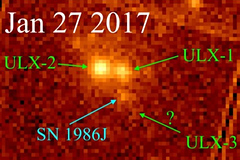US Scientists Explore Three Mysterious Objects 30 Million Light-Years From the Sun

Image: Earley
Scientists at the Universities of Chicago and Fordham in the United States studied three ultra-bright X-ray sources (ULX) in the spiral galaxy NGC 891. Each of them emits more X-ray radiation than one million Suns at all wavelengths. The exact nature of this phenomenon is still a mystery. Research findings that will help explain ULX are published in the journal arXiv.
Astronomers analyzed data collected by NASA's Chandra X-ray Observatory and the European Space Agency's XMM-Newton spacecraft. They were interested in 17 years of observations of the edge-on spiral galaxy NGC 891 with a bar located at a distance of 30 million light years, as it houses three super-bright X-ray sources – ULX-1, ULX-2 and ULX-3.
The spectrum of the ULX-1 source varied from 203 to 2016, and the light curve decreased, especially from 2000 to 2003. Nevertheless, the source remained stable and did not change much over the entire observation period. Its luminosity was 8.4 x 10 to the 39th power of erg per second. For comparison, the luminosity of the Sun is 3.8 x 10 to the 33rd power of erg per second.
The ULX-2 emitted a constant radiation flux that was 20-50 percent stronger than the ULX-1. Finally, ULX-3 turned out to be the faintest source, with a luminosity of 2 x 10 to the 39th power of erg per second. The radiation flux decreased sevenfold from November 2016 to January 2017, which is why the source is no longer classified as super-bright. At the moment, it is closer to X-ray binaries – binary systems whose X-rays are generated by the fall of matter from a star onto a compact object like a black hole or neutron star.
To explain the nature of all three sources, scientists modeled several scenarios that take into account the results of observations. They considered options such as a supernova, a tidal destruction event, an accreting source with superaddington luminosity, and X-ray binaries. The first two sources are most likely black holes with a mass of 50-80 Suns, whose luminosity exceeds the Eddington limit (shows the amount of radiation for an object in a state of equilibrium with gravity and radiation pressure). As for the third ULX-3 source, so far scientists have too little data at their disposal to unambiguously judge its nature, although its luminosity corresponds to a black hole with a mass of 20 Suns.

